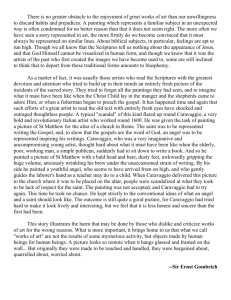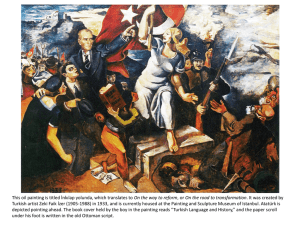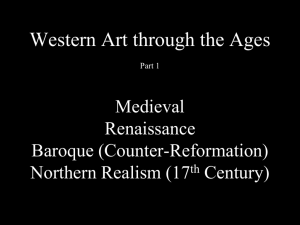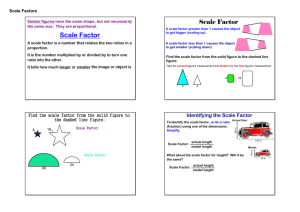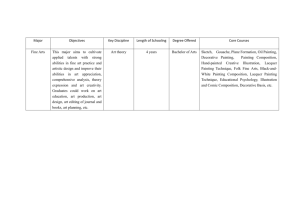artists and period presentation
advertisement
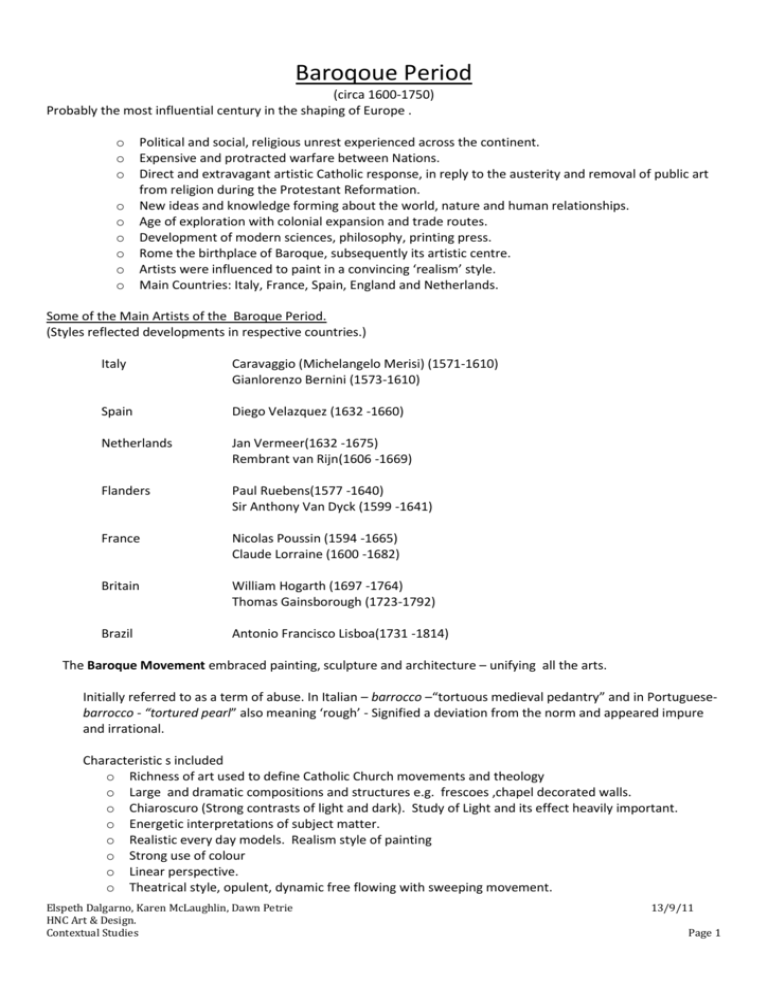
Baroqoue Period (circa 1600-1750) Probably the most influential century in the shaping of Europe . o o o o o o o o o Political and social, religious unrest experienced across the continent. Expensive and protracted warfare between Nations. Direct and extravagant artistic Catholic response, in reply to the austerity and removal of public art from religion during the Protestant Reformation. New ideas and knowledge forming about the world, nature and human relationships. Age of exploration with colonial expansion and trade routes. Development of modern sciences, philosophy, printing press. Rome the birthplace of Baroque, subsequently its artistic centre. Artists were influenced to paint in a convincing ‘realism’ style. Main Countries: Italy, France, Spain, England and Netherlands. Some of the Main Artists of the Baroque Period. (Styles reflected developments in respective countries.) Italy Caravaggio (Michelangelo Merisi) (1571-1610) Gianlorenzo Bernini (1573-1610) Spain Diego Velazquez (1632 -1660) Netherlands Jan Vermeer(1632 -1675) Rembrant van Rijn(1606 -1669) Flanders Paul Ruebens(1577 -1640) Sir Anthony Van Dyck (1599 -1641) France Nicolas Poussin (1594 -1665) Claude Lorraine (1600 -1682) Britain William Hogarth (1697 -1764) Thomas Gainsborough (1723-1792) Brazil Antonio Francisco Lisboa(1731 -1814) The Baroque Movement embraced painting, sculpture and architecture – unifying all the arts. Initially referred to as a term of abuse. In Italian – barrocco –“tortuous medieval pedantry” and in Portuguesebarrocco - “tortured pearl” also meaning ‘rough’ - Signified a deviation from the norm and appeared impure and irrational. Characteristic s included o Richness of art used to define Catholic Church movements and theology o Large and dramatic compositions and structures e.g. frescoes ,chapel decorated walls. o Chiaroscuro (Strong contrasts of light and dark). Study of Light and its effect heavily important. o Energetic interpretations of subject matter. o Realistic every day models. Realism style of painting o Strong use of colour o Linear perspective. o Theatrical style, opulent, dynamic free flowing with sweeping movement. Elspeth Dalgarno, Karen McLaughlin, Dawn Petrie HNC Art & Design. Contextual Studies 13/9/11 Page 1 Timeline Notes of Interest: 1645 1648 1662 French Royal Academy of Painting and Sculpture founded 30 Year war ends, destroying many countries finance/ability to pay for art. Royal Society founded in London Baroque works of art were often funded by the patronage of the Vatican and the Catholic Church. European Royal Families and Heads of State, rich aristocrats and wealthy merchants in commerce all contributed funds. In some instances, artists were used politically. Some countries had vast wealth before the 30 year war, and commissions from private and public interest were readily available. Artists’ commissioned works were frequently determined by the source of patronage, portrayed religious and political scenes. Michelangelo Merisi (Caravaggio) (1571-1610) o o o o o Son of an architect. Born in Caravaggio, Milan Highly talented - apprenticed as 11 year old to Simone Peterzano. Began career in Rome as portrait painter and perfecting still life and historical paintings. Travelled extensively round Europe, mainly due to his fiery temper and antagonising people throughout his life. Characterised by: Religious narrative subjects. Portrayed biblical characters as ordinary, everyday people. Insisted on painting from studio model. Secular pictures often disguised Christian content. Painted directly without drawing out initial composition. Strong realism with strong contrasts and interplay of lights and darks(Chiaroscuro) Use of colour in its purest form. o Despite receiving patronage from the Vatican and Cardinal Maria Del Monte, Caravaggio struggled to sell paintings and relied on charity until his death. Caravaggio Supper at Emmaus c. 1600-1601 Oil on canvas 138 x 195cm http://www.theartgallery.com.au/ArtEducation/greatartists/Caravaggio/supper/supper.jpg Accessed: 07/09/2011 Elspeth Dalgarno, Karen McLaughlin, Dawn Petrie HNC Art & Design. Contextual Studies 13/9/11 Page 2 Caravaggio Title: St Catherine of Alexandria c. 1598 Oil on canvas, 173 x 133 cm Important Works Boy with a basket of Fruit (1593 – 94) The Calling of St Matthew (1599 -1600) The Crucifixion of Saint Peter (1600-01) Flagellation of Christ (1606-07) http://www.artgallery2000.com/gallery/images/S-Catherine-of-Alexandria-c-1598.jpg Accessed: 07/09/201 Sir Anthony Van Dyck (1599 -1641) o Son of Antwerp textile merchant. o Established own studio at age of 16. o Appointed as official Court Painter to Charles 1st o Travelled widely in Italy. Characterised by: Mythological and Religious works – grand images From 1627 onwards, increasingly painting Aristocratic portraits of royal court and high society sitters. Strong colours, bold and dramatic with effective use of light. Rough visible brush strokes. Forms suggested, but not detailed in their finish. Treated women with sensitivity and sympathy. Recieved commissions and patronage from Royal household and wealthy Aristocrats. Awarded with a Knighthood by Charles 1st. Important influence on subsequent English painters such as Gainsborogh and Reynolds. Sir Anthony van Dyck Lady Elizabeth Thimbleby and Dorothy, Viscountess of Andover 1637 http://www.artchiv.info/galerie/_large.php?workID=10729 Accessed on 07/09/2011 Elspeth Dalgarno, Karen McLaughlin, Dawn Petrie HNC Art & Design. Contextual Studies 13/9/11 Page 3 Sir Anthony van Dyke Samson and Delilah Circa 1630 Accessed on 07/09/2011 Important Works The crowning of Thorns (1620) Self portrait (1620-21) Ladies in waiting to Queen Henrietta Maria (1637) Equestrian Portrait of Charles 1 (1667) Jan Vermeer (1632-1675) Dutch As few as 40 known works ‘Discovered’ in 1866, by French art critic and historian, Théophile Thoré Was an extremely private individual and little is known about his personal life/persona. During his early years as a painter, Vermeer was not short of commissions or work, however due to the 30 year war Vermeer and his family were left bankrupt. Died at an early age Characterised by: Photographic realism Subtle depictions in Light and Shadow Amazing understanding and use of light Chose scenes of ‘apparent’ ordinariness, often domesticity Influenced by the colours used in Delft ceramics Jan Vermeer ca. 1666 Allegory of the Art of Painting In this painting Vermeer portrays an artist painting the Muse of HistoryCleo. It is suggested that Vermeer felt history was extremely important to the Visual arts. We can see Vermeer’s amazing use of light in full effect, with the model, artist and scene lit entirely by the light through the window. Creating subtle realism yet, retaining intricate detail and strong colour. http://www.students.sbc.edu/mclemore10/The Allegory of Painting.html Elspeth Dalgarno, Karen McLaughlin, Dawn Petrie HNC Art & Design. Contextual Studies 13/9/11 Page 4 Jan Vermeer Woman Holding a Balance C. 1664 http://www.nga.gov/feature/vermeer/moment1.shtm Again we can see Vermeer’s incredible use of light and colour and strong compositional elements. Important Works: Diana and her Companions, 1655-56 Procuress, 1656 Girl Asleep at a Table, ca. 1657 Officer with a Laughing Girl, ca. 1655-60 The Music Lesson, 1662-65 Girl with a Pearl Earring, ca. 1665-66 Allegory of the Art of Painting, ca. 1666 Peter Paul Rubens (1577 -1640) Born 1577 Germany Influenced by Roman Sculpture Theatrical style/use of light Rubens was particularly flamboyant Court painter to the Spanish governors of Flanders and subsequently to Charles I of England And Marie de' Medici, Queen of France Painted religious and hunting themes, landscapes Best known for his oft-unclothed figures Anthony Van Dyck became a prominent student of Rubens Prominent artist, who became popular and extremely well know, subsequently wealthy Characterised by: Use of Pure Colour Study of Light Large scale scenes/many figures Panoramic landscapes Strong compositional elements Peter Paul Rubens Marie de Medici c. 1622 -1630 http://www.students.sbc.edu/vandergriff04/mariedemedici.html Rubens was requested to paint a series of work of and for Marie De Medici. Elspeth Dalgarno, Karen McLaughlin, Dawn Petrie HNC Art & Design. Contextual Studies 13/9/11 Page 5 Peter Paul Rubens Peace and War c. 1629 – 1630 Here we can see Rubens wonderful use of strong colour and large scale painting. Rubens was also known for painting many figures into his scenes and careful use of composition. http://www.dailyartfixx.com/2009/09/21/international-day-of-peacewar-and-peace-in-art/ Important Works: Marie de Medici Peace and War Portrait of Catherine Manners Autumn Landscape Gialorenzo Bernini( 1598- 1680) o o o o Born in Naples Begun with his father Pietro Bernini a sculptor Italian Artist who was also known as a great sculptor and architect. Pope Paul V was his patron Influenced Bacicco (Italian), Fischer Von Eriach (Italy, Austrian) and Sir Christopher Wren Ecstasy of St Theresa ...1645—1652 Designed to be illuminated to be reflective of light from a hidden window. Important works. Apollo and Daphnia 1622—1624 Cornaro Chapel 1647—1652 Ecstasy of St Theresa 1645--1652 Elspeth Dalgarno, Karen McLaughlin, Dawn Petrie HNC Art & Design. Contextual Studies 13/9/11 Page 6 Apollo and Daphne Part of the Cornaro Chapel 1647 – 1652 Diego Velázquez (1599-1660) o o o o o o o Born in Seville 1599 Thought to be of Noble Portuguese descent Student of Fracisco Pachees Married Pachees’ daughter Philip IV became his Patron He went to Italy twice 10yrs apart but spent most time in court. He was court painter and also had the position in court as Marshal of the Royal Household. He prepared for ceremonies which they say the last one, a wedding killed him as not long after he died exhausted. Characterised by..... o Mythological, Religious and common life scenes o Kitchen scenes strong dark and light colours o Swift brush strokes called virtuoso or brava o The Venus was the 1st known example of female nude o He was compared to Michelangelo, Avagio and Rubens. Important works Toilet of Venus 1650 Christ in the House of Mary and Martha 1618 Las Meninas 1656 Old Woman Cooking Eggs 1618 Elspeth Dalgarno, Karen McLaughlin, Dawn Petrie HNC Art & Design. Contextual Studies 13/9/11 Page 7 Diego Velazquez The Toilet of Venus 1650 Diego Velazquez Christ in the house of Martha and Mary 1618 Diego Velazquez Old Woman Frying Eggs 1618 Elspeth Dalgarno, Karen McLaughlin, Dawn Petrie HNC Art & Design. Contextual Studies 13/9/11 Page 8 References Books Alfred Moir (1989) Caravaggio,Harry N Abrams,Inc.,New York (ISBN 0-500-08038) Jordi Vigué(2002) Great masters of Western Art. Watson-Guptill Publications (ISBN 0-8230-21130) Prof. William Vaughan Encyclopaedia of World Art(ISBN 978-1-84013-916) Hawksley, Cunningham, Payne & Bradley (2000) Essential History of Art, Bath, Parragon Books (ISBN 0 -75253-6966) Hugh Honor & John Fleming (1984) A World History of Ar.,7th ed. London. Laurence King Publishing (ISBN 1-85669448-8) Websites http://www.artgallery2000.com/gallery/images/S-Catherine-of-Alexandria-c-1598.jpg http://www.theartgallery.com.au/ArtEducation/greatartists/Caravaggio/supper/supper.jpg Accessed on 07/09/2011 http://www.artgallery200.com/gallery/st-catherine-of-alexandra-c-1598-by-caravaggio-p-4968.html http://staff.jccc.net/jjackson/reformation.htm http://www.historyylearningsite.co.uk/How-successful-was-the-Counter-Reformation.htm http://www.strategos.demon.co.uk/tywhome http://history.wise.edu/sommerville Accessed on 06/09/2011 Books Roy Bolton (2004) A Brief History of Painting, Robinson. (ISBN 1-84119-957-5 Belinda Thomson (1998) Movements in Modern Art Post-Impressionism, Tate Gallery Publishing (ISBN 185437254 8) Sister Wendy Beckett (1997) Sister Wendy’s Story of Painting, Dorling Kindersley Limited, (ISBN 0751301337) Tansey and Kleiner Gardner’s Art Through the Ages Tenth Edition, Harcourt Brace College Publishers Gaetan Picon (1991) The Birth of Modern Painting, Mallard Press (ISBN 0792455282) Websites http://www.students.sbc.edu/vandergriff04/mariedemedici.html http://www.dailyartfixx.com/2009/09/21/international-day-of-peacewar-and-peace-in-art http://www.nga.gov/feature/vermeer/moment1.shtm http://www.students.sbc.edu/mclemore10/The Allegory of Painting.html http://www.artcyclopdeia.com http://www.arthistory.about.com Elspeth Dalgarno, Karen McLaughlin, Dawn Petrie HNC Art & Design. Contextual Studies 13/9/11 Page 9
